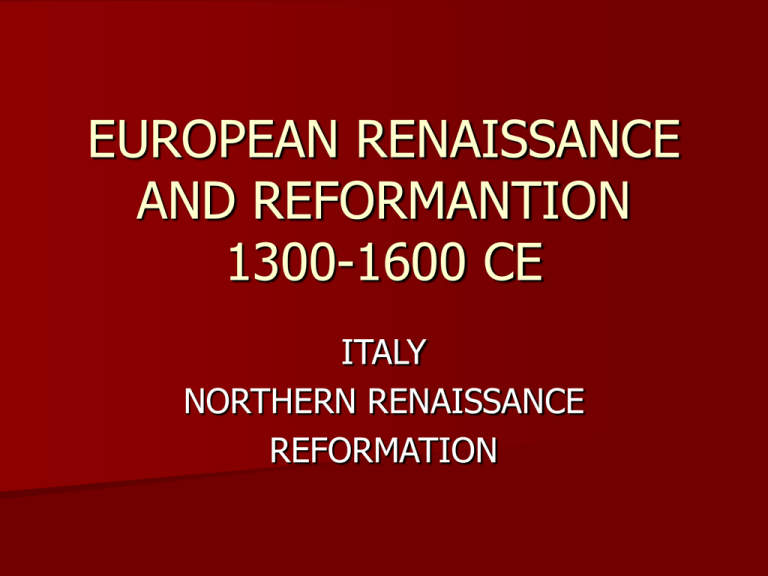EUROPEAN RENAISSANCE AND REFORMANTION 1300
advertisement

EUROPEAN RENAISSANCE AND REFORMANTION 1300-1600 CE ITALY NORTHERN RENAISSANCE REFORMATION ITALY Renaissance – 1300-1600 CE – a rebirth or revival of art and learning; Classical culture of Rome and Greece. Medici Family – 1434 CE – a powerful banking family who controlled Florence’s government. (city-state) ITALY Humanism – an intellectual movement that focused on human potential and achievements; study of history, literature, and philosophy. Secular – Renaissance society was worldly rather than spiritual. Patrons – Church leaders, merchants, and wealthy families who financially supported the arts. ITALY Renaissance Man – a man who excelled in many fields – “universal man.” (well educated in classics, dance, sing, play music, write, rider, wrestler, and swordsman) Renaissance Woman – they should know the Classics and be charming. ITALY 1. 2. 3. 4. Renaissance Art – they used perspective – technique which shows three dimensions on a flat surface. Artists: Michelangelo – used realistic style for depicting human bodies. Donatello – realistic sculpture. Leonardo da Vinci – “Renaissance Man” – painter, sculptor, inventor, and scientist. (Mona Lisa) Raphael – famous for use of perspective. ITALY 1. 2. 3. 4. Renaissance Writers – some wrote their books in the vernacular – the native language. Writers: Francisco Petrarch – wrote humanistic poems or sonnets. Boccaccio – Decameron a tragic and comic view on life. Niccolo Machiavelli – The Prince – a book about political power. Vittoria Colonna – wrote poems that expressed her emotions. NORTHERN RENAISSANCE 1. 2. By the 1490 CE – Renaissance ideas spread to Northern Europe. German Painters: Albrecht Durer – painted religious subjects. Hans Holbein – painted portraits of famous people. NORTHERN RENAISSANCE Flemish Painters: 1. Jan van Eyck – used oil painting 2. Pieter Bruegel – used realistic detail for individual people. NORTHERN RENAISSANCE 1. Northern Renaissance Writers: Desiderius Erasmus – Christian humanist – The Praise of Folly 2. Thomas More – Christian humanist – Utopia – an imaginary place where greed and corruption had been weeded out. REFORMATION 1. 2. 3. 4. 5. 6. 7. 8. Causes of the Reformation: Humanism and Secularism lead people to question the Church Printing press helps spread criticisms of the Church Powerful monarchs challenge the Church’s supreme power in Europe. Pope is view as a foreign ruler European monarchs are jealous of the Church’s wealth Merchants resented paying Church taxes Some Church leaders are corrupt Sale of indulgences were unacceptable for some people. REFORMATION 1. 2. 3. Martin Luther – 1483-1546 CE – German monk who was troubled by the selling of indulgences or pardons; he wrote the 95 These – a formal statement attacking the pardon merchants. Salvation through faith in God’s forgiveness. Church teachings should be based on the Bible. All people of faith were equal. Reformation – a religious movement that led to the founding of Christian churches that did not accept the pope’s authority. Lutherans – a separate Christian group. REFORMATION Protestantism – a branch of Christianity that developed out of the Reformation. Peace of Augsburg – 1555 CE – in Germany a compromise that allowed princes to determine the religion of their state. REFORMATION Henry VIII – 1527 CE – king of England; desired to have a male heir. He tried to have his marriage annulled or set aside by the pope, so he could remarry. The pope refused. Act of Supremacy – the parliament made Henry the official head of England’s Church. REFORMATION 1. 2. 3. Henry’s three children ruled England after his death: Edward VI – 1547 CE – protestant advisors introduced reforms in English Church. Mary – 1553 CE – devout Catholic; brought back the Roman Catholic Church. Elizabeth I – 1558 CE – reestablished the Church of England or Anglican Church REFORMATION Huldrych Zwingli – 1520 CE – Swiss Catholic priest who called for more personal faith and control in the Church. Calvinism – 1536 CE – founded in France by John Calvin (Institutes of Christian Religion) – a belief that God has known since the beginning of time who would receive salvation. Calvin established a theocracy in Geneva, Switzerland in 1540 CE. Presbyterians – 1559 CE – founded by John Knox in Scotland; each religious community was led by church elders. REFORMATION Anabaptists – they believed persons who were old enough to decide to be Christian should receive Baptism; re-baptism in adulthood. Catholic Reformation or Counter Reformation – 1521 CE – Ignatius of Loyola who created the Jesuit order of priestswho were well-trained teachers. REFORMATION 1. 2. 3. 4. Council of Trent – 15451563 CE – results: The Church’s interpretation of the Bible was final. Christians needed faith and goods works for salvation. The Bible and Church tradition were equal authorities for guiding Christian life. Indulgences were valid expressions of faith.











